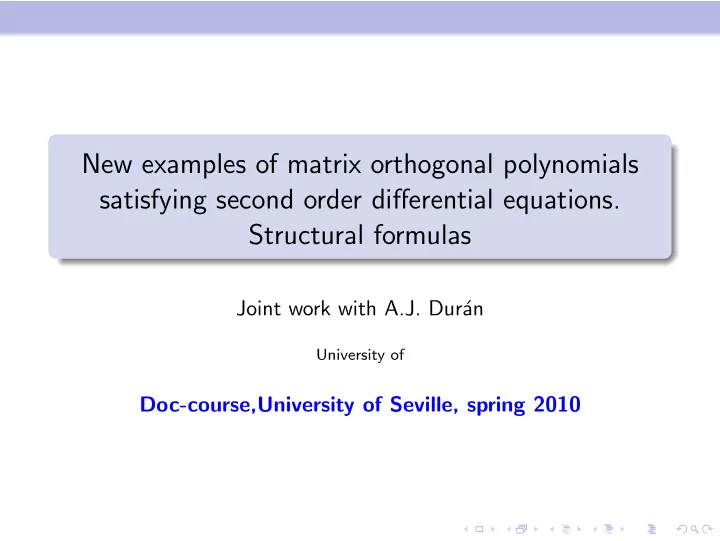

New examples of matrix orthogonal polynomials satisfying second order differential equations. Structural formulas Joint work with A.J. Dur´ an University of Doc-course,University of Seville, spring 2010
Introduction Given a self-adjoint positive definite matrix valued weight function W ( t ) (of dimension N × N ) consider the skew symmetric bilinear form defined for any pair of matrix valued functions P ( t ) and Q ( t ) by the numerical matrix � P ( t ) W ( t ) Q ∗ ( t ) dt, � P, Q � = � P, Q � W = R where Q ∗ ( t ) denotes the conjugate transpose of Q ( t ) . There exists a sequence ( P n ) n of matrix polynomials, orthonormal with respect to W and with P n of degree n . The sequence ( P n ) n is unique up to a product with a unitary matrix.
INTRODUCTION Property Any sequence of orthonormal matrix valued polynomials ( P n ) n satisfies a three term recurrence relation A ∗ n P n − 1 ( t ) + B n P n ( t ) + A n +1 P n +1 ( t ) = tP n ( t ) , where P − 1 is the zero matrix and P 0 is non singular. A n are nonsingular matrices and B n hermitian. Considering possible applications of MOP it is natural to concentrate on those cases where some extra property holds.
The Matrix Bochner’s Theorem In the nineties, A. Dur´ an takes a step in this direction raising the problem of characterizing MOP which satisfy second order differential equations . Dur´ an, Rocky Mountain J. Math (1997) Characterize all families of MOP satisfying ′′ ′ P n ℓ 2 ,R = P n F 2 ( t ) + P n F 1 ( t ) + P n F 0 ( t ) = Λ n P n ( t ) , n ≥ 0 Right hand side differential operator ℓ 2 ,R = D 2 F 2 ( t ) + D 1 F 1 ( t ) + D 0 F 0 ( t ) . P n eigenfunctions, Λ n eigenvalues: P n ℓ 2 ,R = Λ n P n
The matrix Bochner Problem The first examples of MOP, which does not reduce to scalar, satisfying 2 nd order differential equations in the framework of the general theory of orthogonal polynomials appeared in Dur´ an-Gr¨ unbaum , Orthogonal Matrix Polynomials satisfying differential equations Int. Math Res. Not. 2004.
The goal We aim to: Present a new example of MOP , of dimension N × N , satisfying second order differential equations with different interesting properties. To present some structural formulas for the case N = 2 such as Rodrigues formula Recurrence relations
MOP related to second order differential op. Consider the recurrence relation for the sequence MOP ( P n ( t )) n ≥ 0 , orthonormal with respect to a weight matrix W A ∗ n P n − 1 ( t ) + B n P n ( t ) + A n +1 P n +1 ( t ) = tP n ( t ) , where P − 1 is the zero matrix and P 0 is non singular. The examples of MOP satisfying second order differential equations existing up to now in the literature satisfy that A n B n lim ϕ ( n ) = aI, lim ϕ ( n ) = bI, n →∞ n →∞ for a convenient continuous function ϕ ( t ) . The example given here satisfies the property that the previous limits give no longer a scalar matrix
The method to find MOP satisfying 2 nd order differential eq.s (Dur´ n-Gr¨ unbaum), 2004 Simmetry Eqs : differential equations for the weight function W and the coefficients of ℓ 2 ,R = D 2 F 2 ( t ) + D 1 F 1 ( t ) + D 0 F 0 ( t ) . Symmetry Equations WF ∗ F 2 W = 2 2( F 2 W ) ′ F 1 W + WF ∗ = 1 ′′ − ( F 1 W ) ′ ( WF ∗ ( F 2 W ) = 0 − F 0 W ) We put W ( t ) = T ( t ) T ∗ ( t )
The talk continues according to the following suggestions: To carefully present the N × N example and the differential equation. Then to show the 2 × 2 case. Mention the method follow to obtain the generalization (the Theorem 2.3 of the paper [A. Dur´ an, Constructive Approx, 2009]) To present the Rodrigues formula, mentioning how it was obtained, that is, the differential equation for R n which appeared in [A. Dur´ an, Int. Math. Research Notices, 2010] Finally the recurrence relation for the simplest normalization and the recurrence for the orthonormal polynomials, remarking the facts that the limits of the recurrence coefficients are not scalar.
Recommend
More recommend